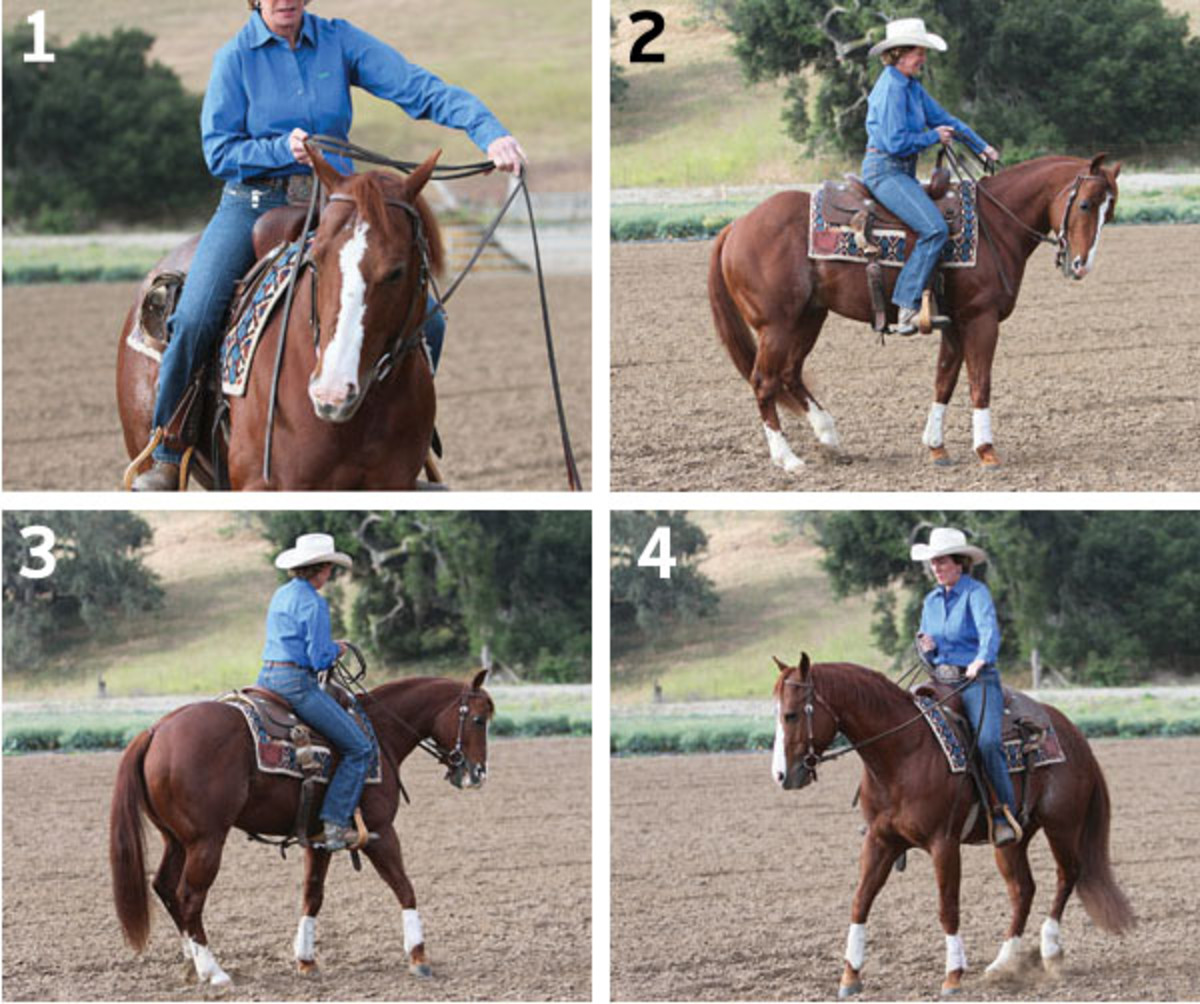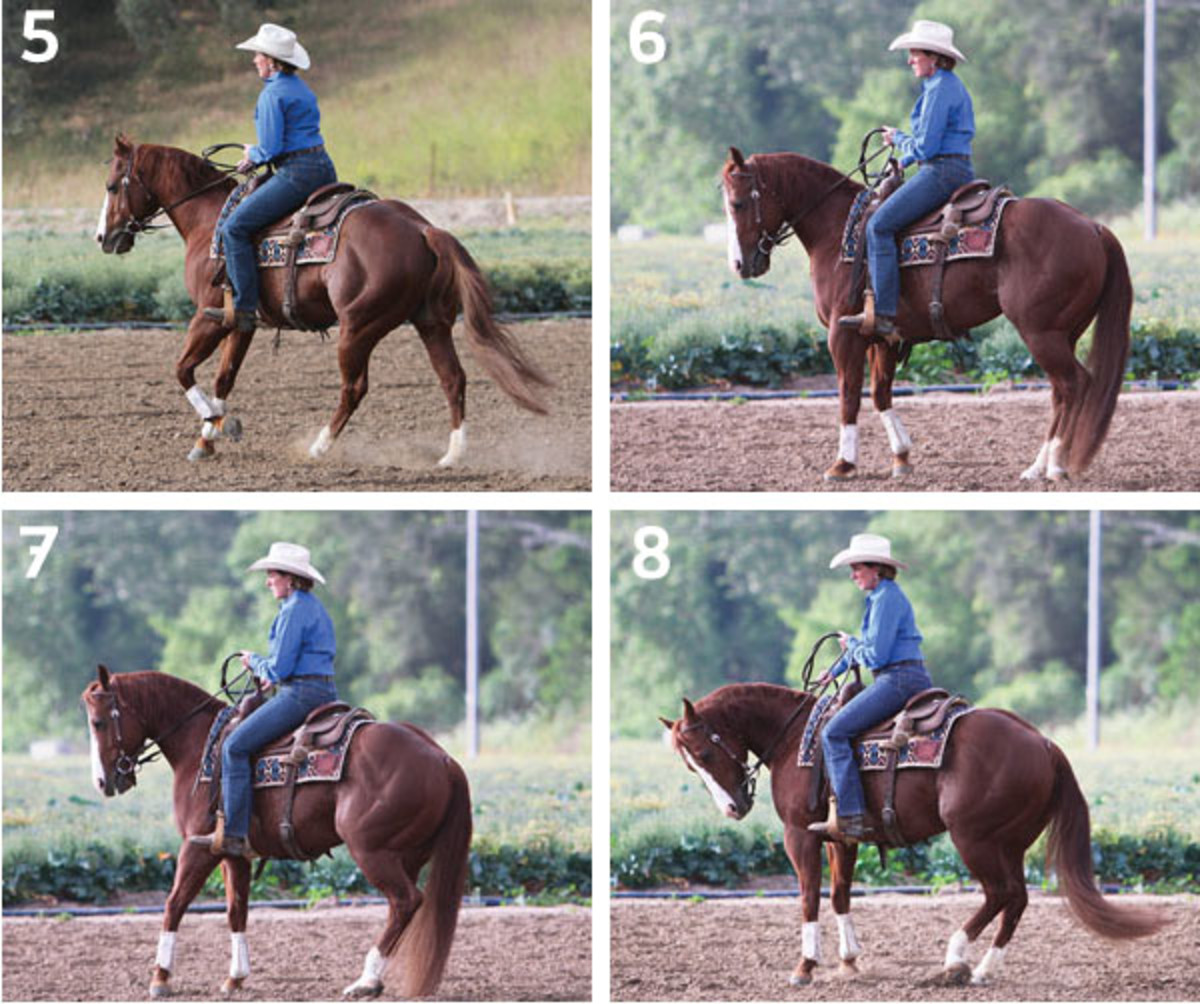Backing your horse in a circle with his nose and hip to the inside focuses your horse’s brain, alleviates leaning issues, and enhances suppleness. Not to mention, it’s a lot of work, so your horse realizes it’s easier for him to maintain focus or stay straight in the first place than to back in circles.
If I have a horse that’s antsy in the middle of the pen before a reining pattern, I’ll take him to a schooling show and back him in circles in each direction in the middle of the arena when he gets nervous and dances around. If a horse is stiff, the exercise loosens him up. I also use it on horses that lean toward the barn when I’m riding in the arena; when the horse starts to lean, I stop him and back a circle on the same arc we were traveling, but in a much smaller circle.
Here, I’m working my horse in a snaffle bit and riding with two hands. Until your horse is fully competent, stick with two hands on a snaffle for the best results. In this article, I’ll discuss tipping your horse’s nose and hind end to the inside of the circle. There are times when you might back him with his nose and hip to the outside, too.
1. Here’s the hand position I’ll use to tip my horse’s nose to the inside. I liken it to going from a neutral hand position and then turning a key in a car’s ignition to tip the nose. To tip my horse’s nose to the right and stand up the right shoulder, I turn my right hand clockwise to a palm-up position, which shortens my rein just enough to tip my horse’s nose in that direction. I move my left hand out to the side to move his shoulders toward the outside of the circle.

2. To teach a horse this exercise, I work incrementally. First I ask the horse to back two steps, which I’m doing here. My hands are fairly neutral, but I’m starting to turn my right palm upward. I place the right rein against my horse’s neck, my left hand moves to the outside, and my legs stay neutral but actively squeeze to ask for two steps back.
3. Then I ask the horse to move his hips two steps to the inside of my “circle.” My right palm is turned up, I place my right rein against his neck, and my left hand is out to my left side. I keep my right leg at the cinch, and my left leg is well behind the cinch to move my horse’s hindquarters to the right two steps. I then move his shoulders out for two steps by pulling my left rein out and putting my right rein against his neck.
4. I continue to work my way around the “circle,” working the two-steps-back/two-steps-hip-inside/two-steps-shoulders-outside pattern. As I go, I start to blend the separate increments together, making more of a circle shape. It’s important to work slowly toward this end goal, releasing the pressure and giving the horse a break every few steps along the way.
5. Here I’m loping my horse on a circle. He’s starting to lean to the inside. This is the perfect exercise to square-up his shoulders. I also use it when a horse drops his shoulder when working a cow.

6. I’ve drawn my horse to a stop and positioned my hands and legs to tip his nose and hip to the inside to start backing a circle. This position will lift his shoulders, as well as supple his body and focus his attention back on what we’re doing and keeping his body in position to do what I ask correctly.
7. I back him a couple steps, move his hindquarters to the inside, and then move his shoulders back out. After two or three circles, I’ll be able to feel my horse stand himself up. More backing in a circle is too much work! It’s easier for him to carry himself correctly.
8. My horse’s shoulders are square, his body is supple, and his mind is focused on going back to work, loping that circle. Once he’s done this exercise a few times, he’ll be much better at backing in a true circle rather than working at it in three increments at a time. n
Sandy Collier, Buellton, California, was the first and only woman thus far to win the National Reined Cow Horse Association’s Snaffle Bit Futurity open division. She’s a highly respected trainer and clinician, as well as an inductee into the National Cowgirl Hall of Fame.






